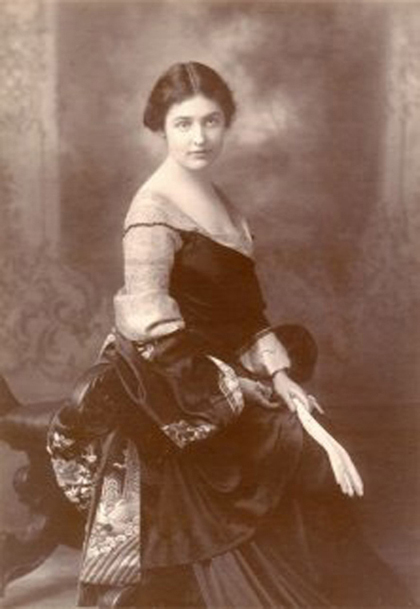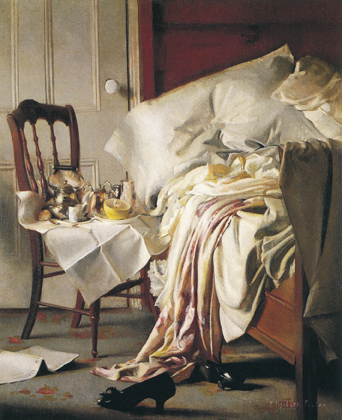Art Essay: Elizabeth Okie Paxton and The Breakfast Tray: The Modernity of a New Woman Artist
By Rena Tobey
ART TIMES Summer 2014
 Elizabeth Okie Paxton. n.d. In the William McGregor Paxton Papers, 1886-1971, Archives of American Art, Smithsonian Institution. |
Pick any period of art history, and only a handful of artists will be remembered. Piecing together the history of women artists injects an additional layer of complexity—women were not encouraged to be a professional artist for most of history. The United States has proven to be no exception, and yet women have earned a living as artists from its colonial days. Resurrecting the career of an artist like Elizabeth Okie Paxton (1877-1971) is especially challenging because only a few of her paintings are in public collections. Further, her archived correspondence centers on her role in managing her husband’s career. William McGregor Paxton (1869-1941) was the beneficiary, like other male artists before, during, and since his time. He benefited from an art-savvy wife who supported his career, using her energy in the bet that his offered the more secure future.
The Breakfast Tray , from about 1910, allows us to get to know an artist almost lost to memory and as arguably her most provocative work, distinguishes Okie Paxton as a modern artist. Drawing on her apparent knowledge of art trends, this painting incorporates in both subtle and more overt ways the issues of her day, while demonstrating her mastery of tantalizing narrative. In a literal way, Okie Paxton links the “old” century with the “new” as a transitional figure, who also had a very modern temperament. Likewise, The Breakfast Tray offers an intelligent nod to art of the past, conveys the ambiguities of its period, and anticipates what modern and contemporary American art will become.
The painting invites us into a world—feminine, messy, sensual, and believable. It is full of personality. Rather than convey a sense of easy domestic harmony, this bedroom can evoke wonder, anxiety, curiosity, titillation, and a variety of narratives that rarely resolve. The artist treats this interior like a still-life composition to be arranged, but then throws it into disarray.
At first, the scene seems deceptively simple. Dappled morning light enters a bedroom, highlighting the silver service of a breakfast tray perched on a chair by an unmade bed. Light glistens off the discarded black pumps. It bounces off the polished, turned knee and spindles of the Windsor-backed chair. Deep shadows—under the shoes, along the chair rails, under the bed—suggest the low level of the rising sun. A newspaper has been tossed away. A dressing gown is ready to slink off the bed, as the lace-trimmed sheets and pillow, still marked with the warm impression of a head, all jumble and tumble toward the floor.
 Elizabeth Okie Paxton. The Breakfast Tray. c1910. Oil on canvas. 21 x 17 in. Private Collection. |
This movement prevents the scene from being a posed still life. Someone has tossed another garment over the footboard. Is it a man’s robe? His trousers? The two pillows kiss in bed. The starched cloth napkin has been jammed up against the seat back of the chair. The succulent grapefruit and abandoned roll are clearly defined, but the silver pieces meld together, blurring certainty. The samovar appears too small in relation to the grapefruit, which overwhelms the matching porcelain mug and jug. The chair is shorter than the doorknob, creating a sense of vertigo from the disproportion. Relative sizes are difficult to assess, so either the room is gigantic or the chair is child-sized. The details do not matter as much as the immersion in the feeling of being in that languorous bed. The painting is at once photographic, impressionistic, and wholly modern.
The tight zoom in on the scene creates immediacy and there-ness, turning the viewer into a voyeur or even an actor in the scene. Immediately, we know that rigorous activity messed up this bed, and with the shoes discarded in haste, the scene appears to be post-coital. Who are the lovers who enjoyed this bed? Where have they gone, apparently in a hurry? Why is the tray set only for one? Was the lover expected? Did one or two people enjoy this breakfast in bed? Who prepared the tray—is it the result of the work of a servant, another unseen participant in this narrative? Part of the joy of the painting is the stories it evokes and indeed demands.
A painting like The Breakfast Tray makes us want to know the artist. The collection of letters that remain document business transactions about her artist-husband’s work, giving us little personal information about her except that she was familiarly known as Betty. Okie Paxton worked within the Boston School of artists, with their focus on beauty, harmony, light, color, clarity, and naturalistic representations of the everyday luxurious world of Boston’s elite. They guarded this domain, even as the modern artistic swell moved past them. To avoid competing with her husband’s traditional interiors, Okie Paxton painted still life works, finding a ready market with private collectors. Consequently, very few of her paintings are available for public viewing in a museum.
Early in her career, she gives us The Breakfast Tray, a work so daring and so unlike the Boston School aesthetic. The interior was a favored subject, but this one is casually messy, middle class, and blatantly sexual. It palpates with an intimacy that makes the viewer a part of what has just happened and what will happen next. We know that Okie Paxton was about thirty-three years old and married when she painted The Breakfast Tray. Are we witnessing their marital bed? Is this a place where she could retreat to be on her own, in this feminized space, a place where she did not have to keep up appearances or be put-together? The Boston School looked to the seventeenth-century Dutch for inspiration. Was Okie Paxton laughing along with Jan Steen (1626-1679) and his messy household paintings that equated a disordered interior with a society in disarray? Or was Okie Paxton satirizing how buttoned up this Boston School was, because she was not bound by it? In the painting, the ordinary black pumps that took their owner out into the world have been tossed aside, as has the newspaper that long represented the male domain of business and politics. Perhaps Okie Paxton was so used to tapping into their power that she knew they were readily available to her again and did not need any special care.
Our painting’s protagonist is a woman of the world, of her time, of her place. She lives in a city, one like Boston, which may have its ties to the old century, but also is finding its way through rapid industrialization, mass immigration, and sweeping technological innovations into an often confusing, changing world. A new youth culture embraces this change as hope for a future very different from the traditions of their parents. One of those differences centers on sexuality and gender roles. The protagonist of The Breakfast Tray is a New Woman. She is educated and the beneficiary of improved health care. She advocates for women’s right to vote, to work outside the home, to go to the theater on her own, and to buy objects she uses to create an intimate space all her own, just as we see in The Breakfast Tray. But hers is not a world without men. She is finding new sexual freedom.
The painting makes us want to know more about the artist who created it. We dig into it trying to learn more about a woman who apparently was not shy, but left little record of who she was and what she cared about. Okie Paxton enjoyed a companionate marriage, unselfishly promoting her husband’s career. As a beauty, she also served as his muse, modeling for many of his paintings. She made choices. One apparently was to pull back from provocative works like The Breakfast Tray, while still satisfying her need to paint through less controversial still life works. She had a visual voice. She had no children. Her life was devoted to art—his and hers. They loved and respected each other. She continued to meticulously manage her husband’s business affairs after his death with correspondence regarding his art estate until 1970, apparently paying even more attention to his posthumous career than her own active one. Could she have been better known had she not married? Had she not married, would she have had access to influential people and teachings that propelled her own development? Unanswerable questions confound us.
What we are left with are a few paintings in known locations, with a stand out, The Breakfast Tray. This painting is so powerful, so personal, and so different from most of her body of work. With still life paintings that suggest order, clarity, comfort, and even opulence, Okie Paxton produced a pleasurable, appealing oeuvre. But this work makes her a painter of note. Coming so early in her productive career, we have to wonder, what if? But ultimately, “what if” is more frustrating than learning “what is.” “What is” is the opportunity to get to know Okie Paxton better, to bring her works out of the shadows and into her own celebration of light, vision, and the modern world.
This essay is the first from the "Finding Her Way" series, exploring the challenges American women artists faced from about 1850 to 1950.
(Rena Tobey is an art historian and lives in New Haven, CT.)
©Rena Tobey, 2014
This essay is the first from the "Finding Her Way" series, exploring the challenges American women artists faced from about 1850 to 1950.
